Posts Tagged: seeds
Mexican Petunia
About three years ago we were given some mystery seeds by a friend. They were from a “dark green plant with blue crepe paper looking blooms”. I planted them in a corner of the garden next to our garage. Within a relatively short period of time, we had a dark green serrated leaf plant that eventually bloomed with bright blue tubular flowers. It froze back in the winter reappearing in the spring. AND it spread but we found it was easy to pull out the miniature self-seeded plants.
I tried to identify this plant without any luck. Sunset Western Garden Book was read from cover to cover, I asked other gardeners who toured our garden and basically had given up the quest. Then last week during a tour at High Hand Nursery in Loomis with the Vaca Valley Garden Club, I spotted our plant. It is a ‘Ruellia brittoncana’ or Mexican petunia. Finally the mystery plant was identified and had a name.
In doing some research, this plant is native to Mexico and easy to grow in dry or wet soil conditions. They are perennial shrubs that grow about 3 feet tall and 4 feet wide. There are some dwarf varieties available such as 'Katie', which grows to 10 inches in height. With little care these plants produce flowers in white, purple or many shades of blue. They resemble the petunia flower we are familiar with, but the two plants are NOT related. Butterflies and hummingbirds are attracted to the colorful blooms, which makes the plants popular with backyard gardeners.
Gardeners either love Ruellia or dislike it due to its invasive nature. There is a sterile version that will not re-seed called 'Purple Showers'; the flowers are deep purple. Though it will not re-seed, it can spread by its roots if grown in wet soil. Sometimes called desert petunias, the more sun they receive the more blooms they produce. You can propagate Mexican petunias by cuttings, seeds or division.
Plant in the early spring and once established you will have blooms throughout the summer into fall. The plant is hardy enough to survive long periods without water, although young plants need regular watering. They adapt easily and grow well in containers, provided they receive sun. And the best news is Ruellia brittoncana is highly resistant to most disease and pests.
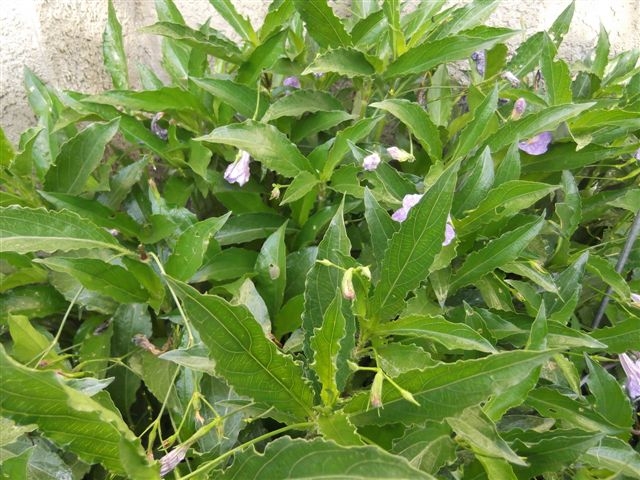
Leaves of the Mexican Petunia. (photos by Sharon Rico)
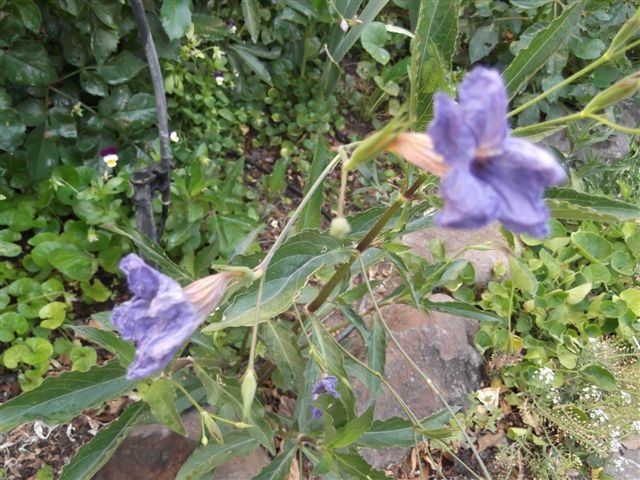
The crepy flower.
Best After-the-Holiday Reading
However, before I go nuts and start ordering everything that calls my name, I must stop, think, and come to my senses, for not all that I see is really what I want and/or need. Precaution must be taken. There are "rules" for ordering from those plentiful books. Just in case you, too, are wanting to go wild, here is a reminder of some common sense guidelines.
First of all, let me say, I prefer catalogs that are printed on recycled paper for obvious reasons. Secondly, I pay more attention to those with photographs of plants, as opposed to those with only drawings. I realize that it is more expensive to produce a book with photos, but I feel I can get a more realistic idea of what I am looking at in a photograph.
Here are some more basic, less personal, things to look for as you drool over the latest offerings:
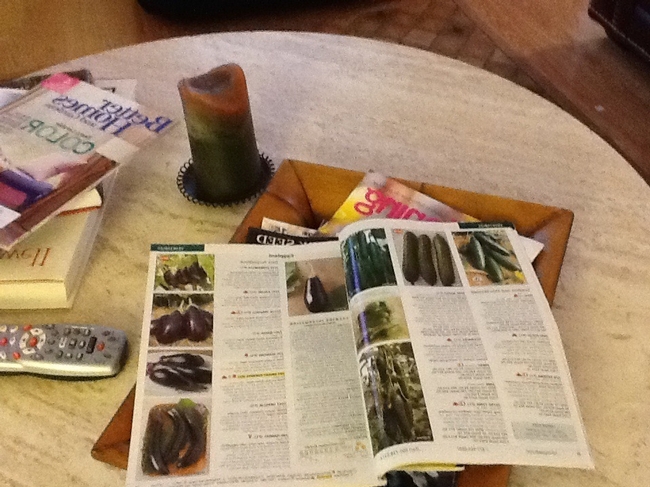
photo by Cheryl Potts
Beware of Tarragon Seeds
Whoops! In my excitement to get some tarragon into my newly planted winter garden, I almost bought a package of tarragon seeds. Little did I know at the time, that tarragon seed packaged for purchase is Russian tarragon (Artemisia dracunculus 'Indorus'), a far less tasty or aromatic herb than its wonderful anise-like cousin, French tarragon (Artemista dracanculus), or True Tarragon. Apparently, one cannot buy French tarragon seeds even if one tried, and the Russian tarragon has little or no flavor.
Once I realized this, I deducted that I would need to start my plant by planting a seedling, a cutting, or a division from an existing plant. Through some research, I also discovered that I would need to wait till spring to obtain my start. Division of this plant every two to three years is important, as, if allowed to do so, its serpentine roots will actually strangle the plant; thereby its name, which came from the French word, "esdragon", which means, "little dragon." Also, division is recommended to simply ensure the plant's vigor and flavor. So if you have a tarragon plant in your garden, dividing and sharing it with another gardener is a natural. (That's a hint.)
Tarragon needs to grow in good draining, loamy soil and makes a lovely potted plant. Though the plant dies back in the winter, mulching the roots is recommended to protect it from frost. It needs moderate water and full to partial sun. Some references say grow in partial to full shade, others recommend sun with some shade in the hottest part of the day. It is probably best to simply keep an eye on your plant and provide some shade if it seems indicated.
The plant most often fails due to being planted in acidic and or wet soil. Flower stems need to removed in late spring to keep the plant productive. The plant can suffer from rotting roots and sometimes mildew.
So, not until next summer will I be cooking my chicken, fish or preparing my salad with my home-grown favorite herb. And since I mentioned cooking, here are a few tarragon tips:
- Add tarragon to a long simmering stew or soup in the last 15 minutes of cooking.
- Slip tarragon leaves under the skin of the chicken you are roasting.
- Freeze or preserve tarragon in white vinegar.
- Dry by hanging a bunch upside down in a warm, dry place.
Bon Appetite!
Hollyhock Harvest
In my Grandmother’s Nebraska garden, hollyhocks (Alcea rosea) towered like church spires. They added vertical relief and color to the horizontal monochromatic flatness of corn and wheat fields. With childhood’s eyes, I can still see their fluffy petals and fuzzy leaves fluttering in a summer breeze. What I never paid attention to, until now, were the seed pods.
Today as I harvest hollyhock seeds from my garden, I notice that a solitary pod looks like a circular version of bank-rolled coins peeking out of a nap-sack wrapper; and a container full of pods, a decorative item in itself.
So this year, instead of tucking the seed pods onto a shelf in the garden shed to await spring planting, I decide to carry my treasures inside and place them on the kitchen table as one might an ornamental collection. I want to teach my grandson that in the fall a garden’s beauty is often found in little things and unusual places.
After all, we’re never too young or too old to learn, “To see a world in a grain of sand and heaven in a wild flower.” [Quotation by English poet William Blake (1757-1827)]
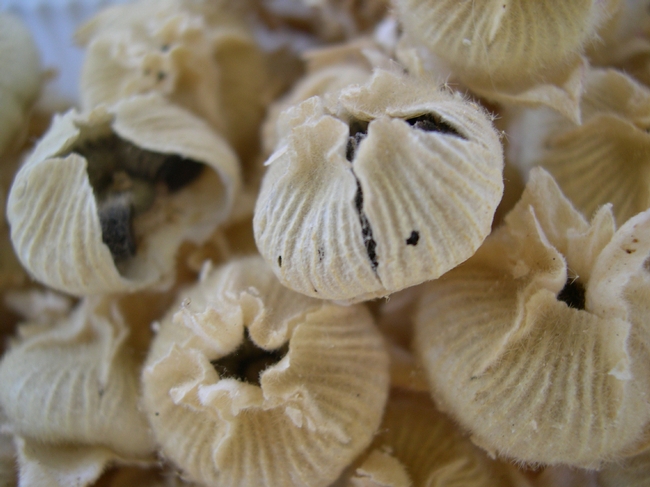
Hollyhock seed pods. (photo by Launa Herrmann)
Wild Boar Farms Tomato Tour 2012
This weekend, I had the pleasure of visiting Wild Boar Farms in Suisun Valley. Wild Boar Farms is certified organic by CCOF and their specialty is growing and breeding unusual and tasty varieties of heirloom tomatoes.
The day began with sampling various varieties of tomatoes grown at Wild Boar Farms and melons grown on an adjacent plot leased by Baker Creek Seeds. There was also wine tasting available. Thereafter, the proprietor of Wild Boar Farms, Brad Gates, led attendees on a tour of his farm. Of particular interest, were his research fields where he is experimenting with breeding different varieties of tomatoes, including one containing anthocyanin, a water-soluble pigment which gives blueberries their blue color. In this case, anthocyanin imparts a bluish hue to Brad’s experimental tomatoes (see picture below).
After Brad concluded his tour, Christian Dake of Baker Creek Seeds, led attendees on a tour of the Baker Creek Seeds plot, where he showed us all the varieties of heirloom vegetables (eggplants galore!), melons, and flowers that Baker Creek Seeds intends to showcase at their upcoming Heirloom Expo at the Santa Rosa Fairgrounds, which runs from September 11 to 13, 2012 (see pictures below).
The day concluded with a wonderful lunch prepared by Fume.
For those of you interested in attending this tour, tickets are still available for the following dates, with different events on each date (see www.wildboarfarms.com for complete details):
WHEN: 11:00 a.m. – 2:00 p.m. on Sundays, August 19, 2012, August 26, 2012, and September 9, 2012
COST: $25.00 / person; $10.00 / child 12 & under; Free for Age 6 & under
WHERE: 2252 Morrison Lane, Fairfield
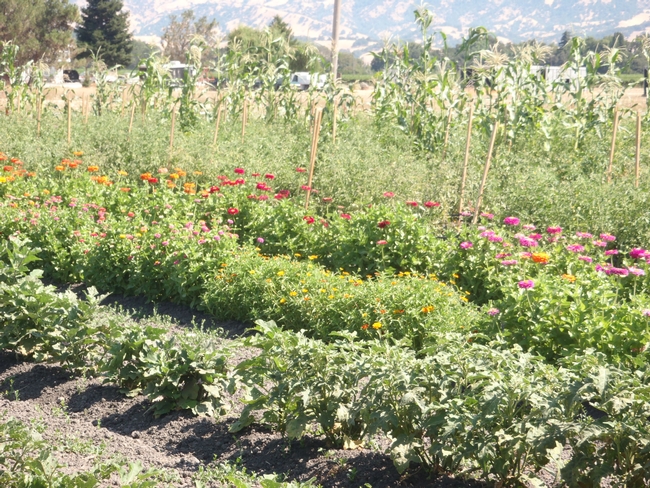
Fields a plenty. (photos by Betty Homer)
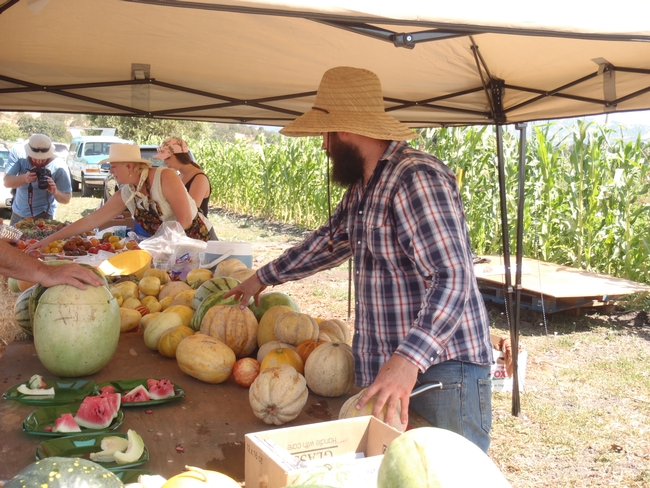
The fruitful bounty.
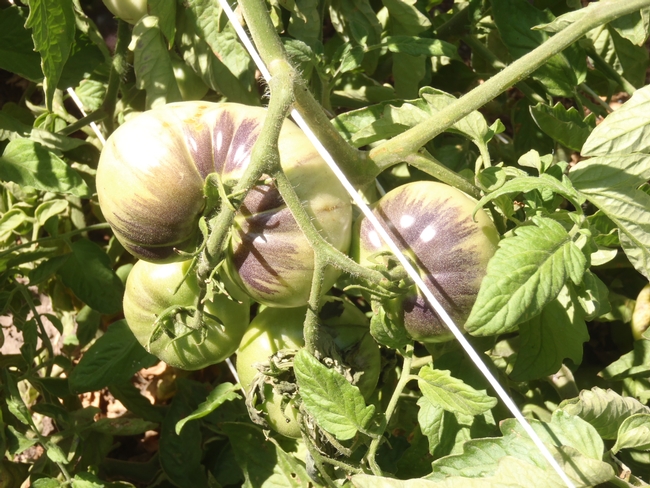
Experimental blue hued tomato.

